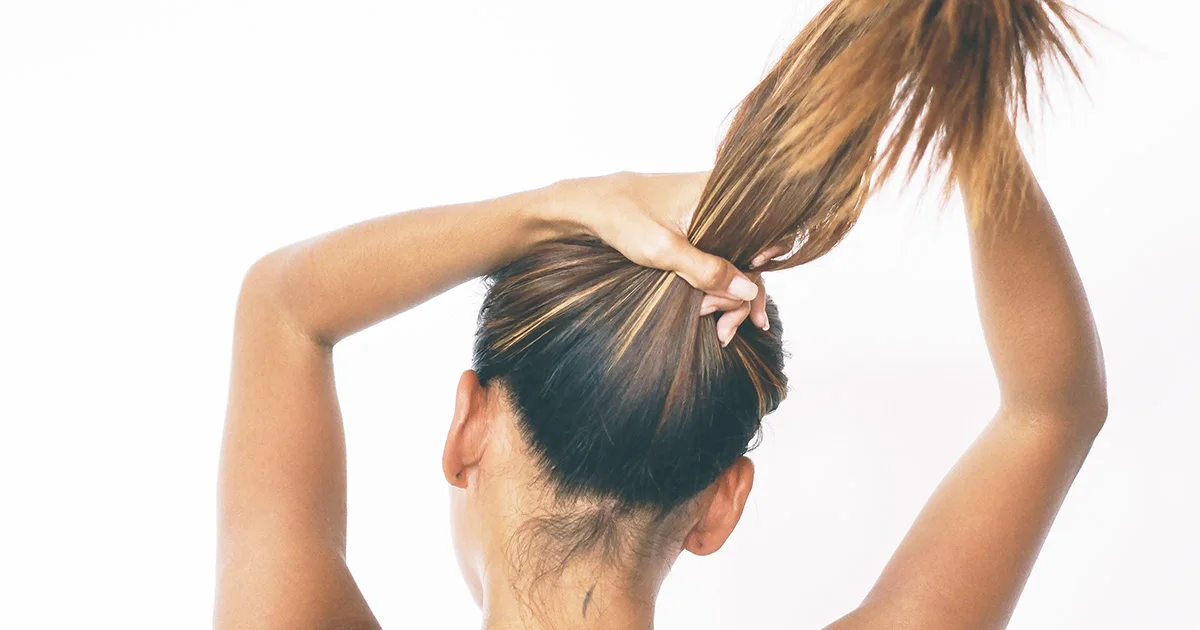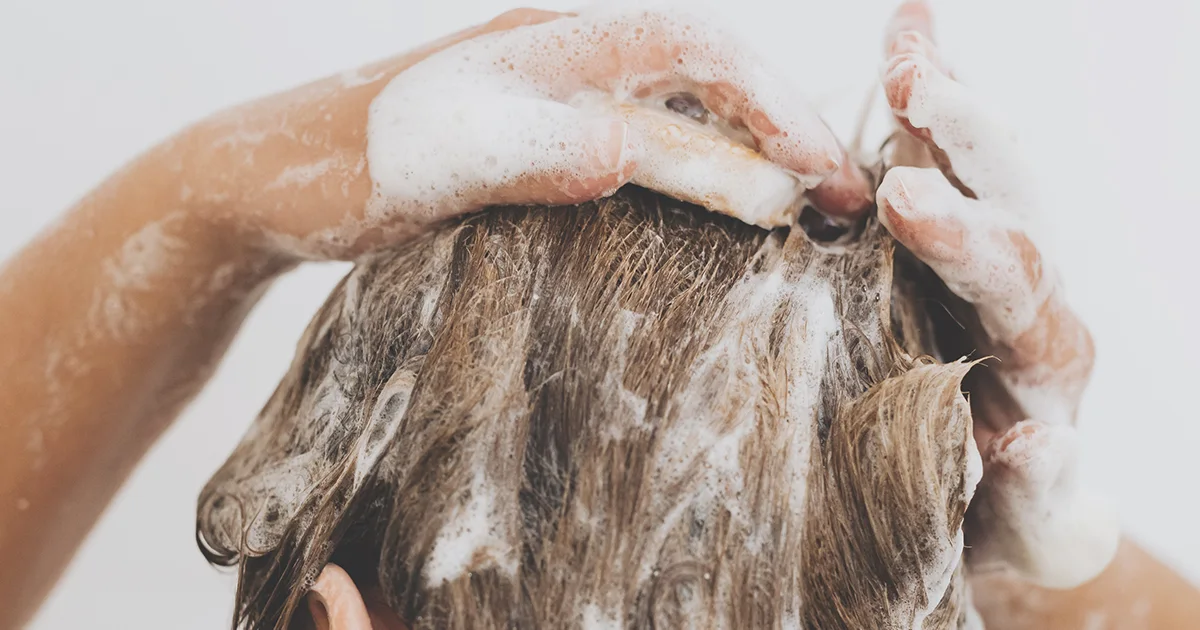Here's what we'll cover
Here's what we'll cover
You can’t miss the health warnings about smoking on TV, online, in magazines, and even right on the label of every cigarette pack on the shelf. They describe at length the dangers toxic chemicals in tobacco pose to your health, like an increased risk of lung cancer and emphysema. But they usually leave out one surprising side effect—smoking can also lead to hair loss.
Can smoking cause hair loss?
Smoking cigarettes has negative effects on many parts of the body, and hair is no exception. Nicotine in cigarette smoke has been linked to several types of hair loss, including:
Pattern baldness: Smoking is linked to male-pattern baldness, or androgenic alopecia (Kavadya, 2022). In one study, 71% of participants who smoked developed extensive male pattern hair loss, while only 10% of non-smokers did. The changes also occured at a younger age than expected (Salem, 2021).
Hairline damage: Some studies associate smoking with hair loss from the front of the hairline and eyebrows (called frontal fibrosing alopecia) (Babadjouni, 2021).
Autoimmune hair loss: Some studies found that people who smoke had a higher risk of autoimmune hair loss (alopecia areata) than those who don’t smoke (Dai, 2020).
Does chewing tobacco cause hair loss?
There’s not much data on whether chewing tobacco can lead to hair loss. However, chewing tobacco (smokeless tobacco) and tobacco smoke contain the same chemicals. Whether someone smokes cigarettes or chews tobacco, they’ll have high levels of nicotine in their hair, so while there’s no direct link between nicotine and hair loss, it’s possible that chewing tobacco has similar effects on the hair (Arain, 2015). There’s also evidence that chewing tobacco is linked to prematurely gray hair (Sabharwal, 2014).
Can vaping cause hair loss?
It’s not clear whether vaping can cause hair loss. Some e-cigarettes are nicotine-based, like tobacco cigarettes. Others include substances like THC, one of the active chemicals in marijuana. While vaping (e-cigarette smoking) is often thought to be “healthier” than smoking, that isn’t always true. The cartridges contain substances that can be damaging to the lungs, and they can be addictive and act as a gateway to cigarette smoking too.
Though there isn’t much research on how vaping affects your hair, one study found that chemicals in e-cigarettes do affect the genes related to epithelial cell growth, possibly even more than traditional cigarettes (Martin, 2016). Since epithelial cells are involved in hair growth, it suggests a possible link between the two (The Belgravia Centre, 2022).
If I stop vaping, will my hair grow back?
When you stop smoking or vaping, it offers you many health benefits—healthier lungs, better blood flow, and improved cancer risks to name a few. Experts aren’t sure whether quitting will cause hair to re-grow. Removing the oxidative stress may help your blood vessels heal and decrease damage to hair follicles, but there isn’t much data from studies.
What are the effects of smoking on hair?
It’s not clear exactly how smoking leads to hair damage, but some possible mechanisms include:
Oxidative stress
Smoking may cause changes in your body that lead to inflammation and an increase in harmful free radicals that damage DNA, a phenomenon known as oxidative stress. Hair follicles are sensitive to oxidative stress, and over time, this can lead to impaired hair growth or hair loss (Trüeb, 2018).
Immune system changes
Chemicals in cigarette smoke may stimulate special immune cells known as B cells and T cells and cause them to attack the body, resulting in autoimmune diseases (diseases where the immune system attacks itself). Autoimmune attack of hair follicles causes alopecia areata, which typically appears as patchy hair loss (Qiu, 2017).
Premature aging and graying
Smoking causes hair to age prematurely and also damages the cells that produce hair color (melanocytes), leading to premature hair graying (Zayed, 2013; Trüeb, 2006).
Decreased blood circulation
Tobacco smoke contains chemicals that damage the small blood vessels in the body and decrease blood flow, including to the small blood vessels that supply the scalp with oxygen and nutrients (known as microcirculation) (Leone, 2013). If small scalp vessels are injured, they can’t carry nutrients to the hair follicles, and the follicles can be damaged (Freiman, 2004).
Scalp damage
Smoking can damage scalp tissue and prevent the tissue from healing properly after a hair transplant, if you choose to go that route. It also reduces blood flow to the scalp. This may result in pain, scarring, decreased hair growth, and rejection of the transplant (Kerure, 2018).
How to quit smoking
Quitting smoking can benefit your health, but it’s not always simple to quit. Luckily, there are a few ways to make quitting easier, including:
Trying nicotine replacements: Substituting nicotine patches or nicotine gum for cigarettes is one way to slowly decrease your dependence on nicotine (Schnoll, 2015).
Talking to your doctor about medication: Some people may benefit from medications like Chantix (varenicline) or Wellbutrin (bupropion), which may lessen nicotine withdrawal symptoms (Barua, 2018).
Involving others: You don’t have to quit on your own—get support from loved ones or healthcare professionals. Counseling (behavioral therapy) is often a helpful step in the quitting process. Support groups can also connect you to others who are struggling to quit, and have been shown to help people make lifestyle changes like quitting smoking.
Options for reversing hair loss
There are many options for stopping or even reversing hair loss, including:
Rogaine: Rogaine (minoxidil) is a topical medication that you apply to your scalp. It’s effective at curbing some types of hair loss and even regrowing some hair, especially if you use it continuously (Badri, 2021).
Propecia: Propecia (finasteride) is typically taken by mouth to slow hair loss and encourage the regrowth of healthy hair.
Supplements: Nutrients like biotin, vitamin C, keratin, and vitamin D may improve hair health and hair thickness. However, there isn’t much data to support nutrient supplementation without an actual nutrient deficiency (Guo, 2017). Check with your healthcare provider to see if you have a deficiency.
Hair transplant: Hair transplants offer a natural-looking replacement for thinning hair. However, it’s a surgical procedure, so it’s more complicated and often more expensive than using medication to regrow hair (Avram, 2017).
Cigarette smoking is tied to many harmful effects on the body, among them hair loss. It’s not clear whether quitting smoking will reverse hair loss, but it may curb the damage, and quitting has other benefits for your overall health. If you have questions about smoking cessation or hair loss solutions, speak to your healthcare provider for more information.
Oral Minoxidil Important Safety Information: Read more about serious warnings and safety info.
Finasteride Important Safety Information: Read more about serious warnings and safety info.
DISCLAIMER
If you have any medical questions or concerns, please talk to your healthcare provider. The articles on Health Guide are underpinned by peer-reviewed research and information drawn from medical societies and governmental agencies. However, they are not a substitute for professional medical advice, diagnosis, or treatment.
Adams T. N. & Morris J. (2022). Smoking. StatPearls . Retrieved on May 18, 2022 from https://www.ncbi.nlm.nih.gov/books/NBK537066/
Arain, S. S., Kazi, T. G., Afridi, H. I., et al. (2015). Correlation of arsenic levels in smokeless tobacco products and biological samples of oral cancer patients and control consumers. Biological Trace Element Research , 168 (2), 287–295. doi:10.1007/s12011-015-0355-y. Retrieved from https://pubmed.ncbi.nlm.nih.gov/25975948/
Avram, M. R., Finney, R., & Rogers, N. (2017). Hair transplantation controversies. Dermatologic Surgery: Official Publication for American Society for Dermatologic Surgery [et al.] , 43 Suppl 2 , S158–S162. doi:10.1097/DSS.0000000000001316. Retrieved from https://pubmed.ncbi.nlm.nih.gov/29064980/
Babadjouni, A., Pouldar Foulad, D., Hedayati, B., et al. (2021). The effects of smoking on hair health: A systematic review. Skin Appendage Disorders , 7 (4), 251–264. doi:10.1159/000512865. Retrieved from https://pubmed.ncbi.nlm.nih.gov/34307472/
Badri, T., Nessel, T. A., & Kumar, D. D. (2021). Minoxidil. StatPearls . Retrieved on May 18, 2022 from https://www.ncbi.nlm.nih.gov/books/NBK482378/
Barua, R. S., Rigotti, N. A., Benowitz, N. L., et al. (2018). 2018 ACC expert consensus decision pathway on tobacco cessation treatment: A report of the American College of Cardiology Task Force on Clinical Expert Consensus Documents. Journal of the American College of Cardiology, 72 (25), 3332–3365. doi:10.1016/j.jacc.2018.10.027. Retrieved from https://www.sciencedirect.com/science/article/pii/S0735109718388594?via%3Dihub
The Belgravia Centre. (2022). New Study May Explain Effect of E-Cigarettes on Hair Loss . Retrieved on May 26, 2022 from https://www.belgraviacentre.com/blog/new-study-may-explain-effect-of-e-cigarettes-on-hair-loss/
Benowitz, N. L., Hukkanen, J., & Jacob, P., 3rd (2009). Nicotine chemistry, metabolism, kinetics and biomarkers. Handbook of Experimental Pharmacology , (192), 29–60. doi:10.1007/978-3-540-69248-5_2. Retrieved from https://www.ncbi.nlm.nih.gov/pmc/articles/PMC2953858/
Dai, Y. X., Yeh, F. Y., Shen, Y. J., et al. (2020). Cigarette smoking, alcohol consumption, and risk of alopecia areata: A population-based cohort study in Taiwan. American Journal of Clinical Dermatology , 21 (6), 901–911. doi:10.1007/s40257-020-00547-7. Retrieved from https://pubmed.ncbi.nlm.nih.gov/32761499/
Freiman, A., Bird, G., Metelitsa, A. I., et al. (2004). Cutaneous effects of smoking. Journal of Cutaneous Medicine and Surgery , 8 (6), 415–423. doi:10.1007/s10227-005-0020-8. Retrieved from https://pubmed.ncbi.nlm.nih.gov/15988548/
Guo, E. L. & Katta, R. (2017). Diet and hair loss: effects of nutrient deficiency and supplement use. Dermatology Practical & Conceptual, 7 (1), 1–10. doi:10.5826/dpc.0701a01. Retrieved from https://pubmed.ncbi.nlm.nih.gov/28243487/
Kavadya, Y. & Mysore, V. (2022). Role of smoking in androgenetic alopecia: A systematic review. International Journal of Trichology , 14 (2), 41–48. doi:10.4103/ijt.ijt_59_21. Retrieved from https://www.ncbi.nlm.nih.gov/pmc/articles/PMC9069908/
Kerure, A. S. & Patwardhan, N. (2018). Complications in hair transplantation. Journal of Cutaneous and Aesthetic Surgery , 11 (4), 182–189. doi:10.4103/JCAS.JCAS_125_18. Retrieved from https://www.ncbi.nlm.nih.gov/pmc/articles/PMC6371733/
Leone, A. & Landini, L. (2013). Vascular pathology from smoking: look at the microcirculation!. Current Vascular Pharmacology , 11 (4), 524–530. doi:10.2174/1570161111311040016. Retrieved from https://pubmed.ncbi.nlm.nih.gov/22022776/
Martin, E. M., Clapp, P. W., Rebuli, M. E., et al. (2016). E-cigarette use results in suppression of immune and inflammatory-response genes in nasal epithelial cells similar to cigarette smoke. American Journal of Physiology. Lung Cellular and Molecular Physiology , 311 (1), L135–L144. doi:10.1152/ajplung.00170.2016. Retrieved from https://www.ncbi.nlm.nih.gov/pmc/articles/PMC4967187/
Mendel, J. R., Baig, S. A., Hall, M. G., et al. (2018). Brand switching and toxic chemicals in cigarette smoke: A national study. PloS One , 13 (1), e0189928. doi:10.1371/journal.pone.0189928. Retrieved from https://www.ncbi.nlm.nih.gov/pmc/articles/PMC5764241/
Qiu, F., Liang, C. L., Liu, H., et al. (2017). Impacts of cigarette smoking on immune responsiveness: Up and down or upside down?. Oncotarget , 8 (1), 268–284. doi:10.18632/oncotarget.13613. Retrieved from https://www.ncbi.nlm.nih.gov/pmc/articles/PMC5352117/
Sabharwal, R., Gupta, A., Moon, N., et al. (2014). Association between use of tobacco and age on graying of hair. Nigerian Journal of Surgery: Official Publication of the Nigerian Surgical Research Society , 20 (2), 83–86. doi:10.4103/1117-6806.137308. Retrieved from https://www.ncbi.nlm.nih.gov/pmc/articles/PMC4141451/
Salem, A. S., Ibrahim, H. S., Abdelaziz, H. H., et al. (2021). Implications of cigarette smoking on early-onset androgenetic alopecia: A cross-sectional study. Journal of Cosmetic Dermatology , 20 (4), 1318–1324. doi:10.1111/jocd.13727. Retrieved from https://pubmed.ncbi.nlm.nih.gov/32946667/
Schnoll, R. A., Goelz, P. M., Veluz-Wilkins, A., et al. (2015). Long-term nicotine replacement therapy: a randomized clinical trial. JAMA: Journal of the American Medical Association, Internal Medicine , 175 (4), 504–511. doi:10.1001/jamainternmed.2014.8313. Retrieved from https://www.ncbi.nlm.nih.gov/pmc/articles/PMC4410859/
Trüeb, R. M., Henry, J. P., Davis, M. G., et al. (2018). Scalp condition impacts hair growth and retention via oxidative stress. International Journal of Trichology , 10 (6), 262–270. doi:10.4103/ijt.ijt_57_18. Retrieved from https://www.ncbi.nlm.nih.gov/pmc/articles/PMC6369642/
Trüeb, R. M. (2006). Pharmacologic interventions in aging hair. Clinical Interventions in Aging , 1 (2), 121–129. doi:10.2147/ciia.2006.1.2.121. Retrieved from https://www.ncbi.nlm.nih.gov/pmc/articles/PMC2695167/
Trüeb, R. M. (2015). The impact of oxidative stress on hair. International Journal of Cosmetic Science , 37 Supplement 2 , 25–30. doi:10.1111/ics.12286. Retrieved from https://pubmed.ncbi.nlm.nih.gov/26574302/
Yamada, T., Hara, K., Umematsu, H., et al. (2013). Male pattern baldness and its association with coronary heart disease: a meta-analysis. BMJ Open , 3 (4), e002537. doi:10.1136/bmjopen-2012-002537. Retrieved from https://www.ncbi.nlm.nih.gov/pmc/articles/PMC3641488/
Zayed, A. A., Shahait, A. D., Ayoub, M. N., et al. (2013). Smokers' hair: Does smoking cause premature hair graying?. Indian Dermatology Online Journal , 4 (2), 90–92. doi:10.4103/2229-5178.110586. Retrieved from https://www.ncbi.nlm.nih.gov/pmc/articles/PMC3673399/










